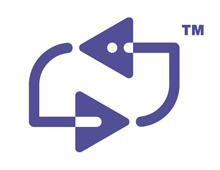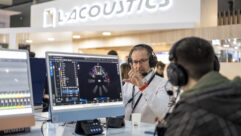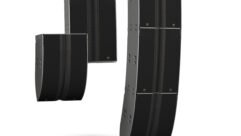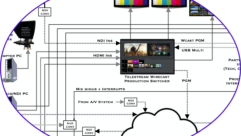

AVB and What Else?
Aug 13, 2012 3:11 PM,
By Bruce Borgerson
Forecasting the Future of Audio Networking
After years of gestation in IEEE meetings and papers, Audio Video Bridging (AVB) is making the transition from engineering consensus to hardware reality. This standards-based specification for synchronized, low-latency networked transmission of streaming media has been hailed as the Holy Grail—or, perhaps more appropriately, the Rosetta Stone—of AV networking. Incorporating additional Layer 2 timing and routing protocols for improved synchronization, AVB also promises interoperability of devices from multiple manufacturers without relying on prepackaged networking solutions from third-party suppliers.
The long-term outlook indeed looks promising. AVB has garnered broad support through the efforts of the AVnu Alliance, an umbrella entity that supports the AVB standards and supervises certification of interoperability among devices from various manufacturers. The AVnu Alliance currently lists 45 companies onboard, representing not only professional AV suppliers but also IT heavyweights like Cisco, Intel, and Texas Instruments.
But what does this mean for consultants and systems integrators already looking at networking solutions five or even 10 years down the road? Will AVB-compliant solutions dominate the industry? Or will proven proprietary solutions still hold large shares of the market with guaranteed interoperability and one-source support?
Frankly, the crystal ball is foggy. To gain a measure of clarity, Sound & Video Contractor queried some major players among audio manufacturers, since these hardware makers will determine in large part what options will be available. Participants are Matt Czyzewski, executive vice president of operations at Biamp Systems; John McMahon, executive director of digital products at Meyer Sound; Klas Dalbjorn, product research manager at Lab.gruppen /Lake (part of the TC Group); Richard Zwiebel, vice president systems strategy at QSC Audio; and Steve Seable, systems design engineer at Yamaha. Lee Minich, president of Lab X Technologies, was invited to comment on behalf of AVnu, where he serves as marketing work group chair. All companies except QSC have signed on to the AVnu Alliance.
AVB: A HARDWARE REALITY
At least one thing is clear: AVB has arrived, with the first wave of products now in operation.
“In May we started shipping our Tesira product, which uses AVB as the audio transport protocol,” says Biamp Systems’ Czyzewski. “We have extensive plans for the future, with a road map for Tesira that goes out at least five years and spans a wide range of AV applications.”
Meyer Sound is currently offering its AVB-enabled D-Mitri digital audio platform and CAL column array loudspeakers, according to John McMahon. “We plan on rolling out AVB across our entire product line in a structured fashion, with a focus on the installation market first, and then touring,” he says.
And the future looks promising, as more companies support the technology and debut AVB-enabled products. “There’s a momentum established from having not just AV product manufacturers but also chip manufacturers come on board,” Czyzewski says. “They get interested when they see a wider marketplace developing.”
Klas Dalbjorn of Lab.gruppen acknowledges the long-term potential. “In a five-year perspective, the cost of adding AVB to a product will be low enough to incorporate it into products that do not now offer networking.”
Not surprisingly, AVnu spokesperson Lee Minich agrees with that assessment and predicts it will lead to AVB dominance well within a short span. “If I had to look into my crystal ball, I’d say that AVB will have 70 to 80 percent of the audio market in five years. That’s primarily because the number of networked systems will grow exponentially in that time frame.”
AVB and What Else?
Aug 13, 2012 3:11 PM,
By Bruce Borgerson
Forecasting the Future of Audio Networking
AVB RESTRAINTS
But is there evidence at hand for such optimism? There are, after all, significant bumps and gaps that still need to be addressed. Most notable, of course, is the fact that AVB is largely defined at Layer 2 of the TCP/IP model, which means new AVB-compliant switches are required for the network infrastructure. Interoperability of devices from different manufacturers remains a work in progress.
Czyzewski acknowledges, “AVB is ready for prime time, but there are gaps to fill. Interoperability with other products is still being worked out, and right now we only have a couple of manufacturers with AVB-compatible switches. That needs to be filled out for AVB to gain widespread acceptance.”
For Yamaha’s Steve Seable, AVB’s built-in flexibility adds complications. “Within the IEEE standards, there are appropriately variable ranges. For example, one manufacturer may choose to implement 44.1kHz sampling in their product, and another 48kHz. This creates incompatibility issues within a common format.”
Ironing out those wrinkles is the principal purpose of the AVnu Alliance certification program. “As AVnu rolls out testing procedures and offers more certifications, we will see more opportunities for designers to develop AVB systems that provide great solutions for end users,” Seable says. “Until that process is complete, there is a bit of a gap.”
In addition, we have to factor in the inherent time lag of product development along with marketing considerations on the part of manufacturers. “I suspect some manufacturers are hesitant to pre-announce AVB products prior to launch because doing so could cannibalize current product with existing proprietary solutions,” admits AVnu’s Lee Minich.
That leaves some AVnu Alliance supporters in an ambivalent position. “It’s currently a catch-22 situation,” observes Lab.gruppen’s Dalbjorn. “We will work toward having AVB-compliant products as soon as we can guarantee interoperability.”
PROPRIETARY STRENGTHS
Grumbling about the incompatibility of current proprietary protocols often overshadows the fact that these existing solutions offer proven strengths across a spectrum of applications.
“Since it’s all controlled by a single third-party company, interoperability and compatibility goes hand-in-hand with the product,” Czyzewski says. “If you buy a CobraNet chip from Cirrus Logic and another company does the same, the two products come together seamlessly. You don’t need a consortium to make that happen.”
Czyzewski notes that Biamp now offers two product lines based completely on CobraNet, with new products for the lines slated for the coming year.
Richard Zwiebel of QSC points out the advantage of a single-source solution where networking and end-point DSP are all integrated in one product from one company, as with his company’s Q-Lan network and Q-Sys product lines. “If products are designed to work together from day one, including the software, hardware, and GUI, then they will most likely perform better than products not designed together from the outset,” he maintains.
Zwiebel further notes that many interoperability concerts have been addressed with network bridges. He cites his company’s Q-Lan to CobraNet capability, and notes that most systems will offer analog connectivity for years to come, which still makes sense in a variety of equipment room scenarios.
Furthermore, since many large installed systems are operating fine with proprietary systems, further expansion using the same protocols likely would prove more cost efficient than switching over to AVB. “CobraNet won’t go away as long as it is supported,” Czyzewski says.
John McMahon of Meyer Sound, a strong and early AVB proponent, confirms that the CobraNet option for D-Mitri will remain for the foreseeable future.
AVB and What Else?
Aug 13, 2012 3:11 PM,
By Bruce Borgerson
Forecasting the Future of Audio Networking
KEEPING OPTIONS OPEN
For years, Yamaha has managed the proliferation of networking options by offering MY-card slots in it consoles to accommodate a range of customer needs and preferences. “We will continue to support all of our current networking options for many years to come,” Seable says, “and we already offer effective format bridging in several of our products that have multiple MY-card slots.”
Even some third-party proprietary suppliers are showing flexibility in regard to the emergence of AVB. Audinate’s Dante, for example, will allow users to leverage AVB’s Layer 2 clocking advantages, as well as a path to interoperability with AVB devices, through a firmware upgrade.
“Audinate is working to provide a risk-free transition solution,” says Klas Dalbjorn of Lab.gruppen, “and we see many manufacturers embracing it in products priced at a level that can carry the associated cost.” Yamaha also supports this as an interim alternative, according to Seable. “We have no AVB-only devices now, but in the future it will be possible to upgrade our Dante-enabled products as Audinate has announced.”
WHO’S PROPRIETARY HERE?
In this article, and most other discussions on the topic, “proprietary” refers to networking protocols designed and licensed by individual companies, as opposed to those based on an open IEEE standard. But QSC’s Richard Zwiebel counters that, in a sense, current AVB standards are more “proprietary” as they impose new Layer 2 standards that require use of new AVB-compliant switches, which at this point are few in number and relatively costly. “Other network technologies such as Dante, Livewire, and Q-Lan all do not require specialized AVB switches and work with readily available products,” Zwiebel insists. “That can be a huge advantage, as most IT departments have brands of switches that they already use and are not anxious to change.”
Zwiebel also notes that AVB’s Layer 2 implementation restricts networks to a single LAN, where the Layer 3 IP-based networks can span huge networks comprising multiple LANs. In a bid to retain these advantages and while realizing greater interoperability, Zwiebel and QSC support the AES X-192 initiative, which seeks to foster compatibility among both single-sourced and open-standard networking protocols. But that process admittedly has a long way to go.
BEST ADVICE?
In the meantime, what should the consultant or systems integrator expect from manufacturers five to 10 years down the road?
“If the project is so large that separate LANs are required, or if replacing existing switches with AVB-compliant switches is unrealistic, then I think the best solution is Dante,” says Lab.gruppen’s Dalbjorn. “However, in five to 10 years, we might see a new alternative that offers an interoperable solution and works across LANs.” Meyer’s McMahon admits that switch replacements make AVB a hard choice when existing IT backbones must be used. But regarding new projects, he advises integrators to “take a look at the breadth and depth of manufacturers behind the AVnu Alliance and be assured that the technology is state-of-the-art, robust, and easy to work with. New projects will be much easier as the AVB network switches provide automatic configuration.”
Yamaha’s Seable points out that AVB has the potential for rapid innovations, as its open standards-based foundation is friendly to free-market competition. “We could see competition in software or drop-in hardware modules, which anybody could develop and then have certified by AVnu. This could create a set of new options for manufacturers who want AVB in their products.”
“You need to use what makes the most sense,” advises Matt Czyzewski of Biamp. “If you want to future-proof it, you need to look closely at emerging technologies. But if you’re concentrating on ‘I need to get it to work now’ and anticipate major upgrades in just a few years, then it makes sense to stick with a proprietary protocol for now and slowly introduce newer technologies in the upgrades.”
LET THE TRANSITION CONTINUE
With AVB products installed and operating, audio networking has crossed a significant threshold. But are we on the verge of a new, AVB-dominant era? “I expect InfoComm this year will reach the boiling point where AVB really takes off,” surmises Matt Czyzewski. “Finally, people will see a range of available hardware. It’s been mostly talk until now, but we’ll really see that ecosystem developing as product hits the market.”
But will AVB’s hardware debut stifle the momentum gained in recent years by the newer Level 3 proprietary protocols, all of which can easily piggyback on existing IP networks? QSC’s Richard Zwiebel thinks not. “Today’s networks incorporate many products that transmit data for video, show control, ticketing, point of sale, and signage, and Q-Lan coexists with all of them. I think we need to keep our eyes wide open. We can create a lot of excitement in our own industry, but that will not do much to influence the large companies that control the network world. The tail does not wag the dog.”










